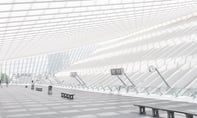Published on
How Technological Advances Will Reshape the Online Student Experience in 10 Years

As the world accelerates to 180 mph, those of us working in the higher education industry (the “we” in this posting) can’t be looking at the front of our cars. We need to be peering into the future, into the horizon. We need to see what’s coming down the pike by scanning the “weak” and “strong” signals to ascertain patterns, and then ask ourselves:
- If these trends continue, how are we going to respond to them?
- Which roads do we want to travel, and which roads do we want to watch others go down?
- How can we move off the crowded highways and onto new/unoccupied roads?
Towards that end, this posting strives to relay a few possible directions where higher education is headed in the not-so-distant future.
Readers of The EvoLLLution already know that the higher education landscape continues to shift beneath our feet. Some, including yours truly, would say higher education is at the embryonic stage of massive change and that our industry is ripe for disruption. After all, I’ve been pulse-checking the future of higher education for years, and what used to be a vision for me is now coming to fruition. What continued forms these changes take — and the level of disruption that occurs — may vary by the type of institution or organization involved. However, the level of disruption may also be related to how tenaciously one clings to the status quo — a dangerous tactic these days.
I say dangerous because, for those institutions who continue to cling to the status quo, they won’t like to acknowledge the fact that the conversation continues to move outside of traditional higher education. The more they try to stay the same, the less relevant they will become. Like water quickly flowing downstream, the water will simply flow around any rocks it encounters (think of things like the DYI University; Uncollege.org; My Education Path; the use of Massively Open Online Courses, or MOOCs — and what they will be morphed into by the corporate world; continued growth of alternative means of proving one’s competence/skills in a particular area).
On a 50,000-foot level:
- We could easily see the increased use of consortia and the pooling of resources to achieve an organization’s goals (and even survival)
- We will surely see new business models develop
- We will surely see more institutions either close up shop, merge completely with others and/or significantly alter their mission/vision
Also, those of us working in higher education must realize we are actually in control of very few things. For example, among other things, we are not in control of:
- How the K-12ers are changing and what their preferences for learning are (or will be)
- The state legislatures and how much funding will be allocated to institutions of higher education
- The world of the technology – such as the Internet of Things, augmented reality, 3D printing and other emerging technologies
- How the economy will go for the rest of this year and in the years to come
- Which careers will be in demand 5-10 years from now
We have watched while the Internet has significantly affected other industries, and now we’re at bat; it’s our turn.
In looking at what the future of higher education might be like for the majority of learners throughout the world, the internet has, and will continue to have, a significant effect on what is possible. A trend that is likely to continue is the decreasing cost of obtaining a degree and/or the costs involved in picking up the skills required to get a decent-paying job. While MOOCs are half-baked, they are an important force – as they are prompting higher education to innovate more, to experiment more. They will continue to apply downward pressure on the price of a degree.
Likely technologies and/or capabilities:
For the physical buildings and learning spaces:
- Large, multi-touch, interactive screens and walls that can not only display information, but that allow numerous students to simultaneously exchange files, URLs and other resources
- Enormous communications pipes as wireless broadband significantly matures
- The ability to more efficiently/powerfully harness contributions from students via the growth and integration of Bring Your Own Device (BYOD) and Bring Your Own Technology (BYOT) initiatives into the teaching and learning processes
- Increased usage of robotics, 3D printing, augmented reality, machine-to-machine communications and different types of Human Computer Interaction (HCI)
- More choice, more control
- Greater usage of real-world assignments/problems/issues that need to be resolved
For the virtual classroom:
- 24x7x365 ubiquitous learning
- A significant increase in the number of formats/outlets for how students can exchange files, URLs and other resources
- The technologies involved in IBM’s Watson, Apple’s SIRI, Google Now, Knewton’s product lines, etc. will integrate with what MOOCs morph into, providing customizable auto-curation,which will make it more possible to drink from the streams of content compared to trying to drink from the current fire hoses. This area also includes:
- Tapping into the power of learning analytics
- Better usage of learning agents, artificial intelligence, web-based learner profiles and intelligent systems/tutoring
- Tapping into Smart/Connected TVs, which will unleash entire cloud-based ecosystems of digitally-based materials originating from open educational resources and publishers, as well as from other learners
- Methods of allowing remote learners to access what’s happening in a physical space, including methods of tapping into mobile learners
- Methods of tapping into other networks, communities of practice and into physically-based learning spaces
- Increased usage of augmented reality, transmedia and digital storytelling, interactive “textbooks,” educational games, different types of Human Computer Interaction (HCI) and machine-to-machine communications
- More choice, more control
- Greater usage of real-world assignments/problems/issues that need to be resolved
For the blended learning spaces:
- A combination of the above technologies, trends and opportunities, using different pedagogies
- More choice, more control
- Higher levels of interactivity
- Greater usage of real-world assignments/problems/issues that need to be resolved
Regardless of whether these exact items occur, I recommend that we strap on our seatbelts, because this is going to be one heck of a ride!
– – – –
References:
Arial Schwartz, “In Cisco’s Classroom Of The Future, Your Professor Is Just An Illusion,” Co.Exist, http://www.fastcoexist.com/1681458/in-ciscos-classroom-of-the-future-your-professor-is-just-an-illusion.
Ian Steadman, “IBM’s Watson is better at diagnosing cancer than human doctors,” Wired UK, February 11, 2013, http://www.wired.co.uk/news/archive/2013-02/11/ibm-watson-medical-doctor
Peter Murray, “Watson is now commercially available, set to help doctors treat cancer,” SingularityHUB, February 13, 2013, http://singularityhub.com/2013/02/13/watson-is-now-commercially-available-set-to-help-doctors-treat-cancer/
Ian Chant, “Watson supercomputer goes to college, Revenge Of The Nerds style antics imminent,” Geekosystem, January 30, 2013, http://www.geekosystem.com/watson-goes-to-college/
Author Perspective: Educator



